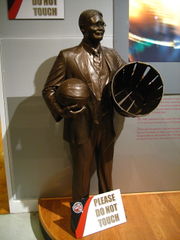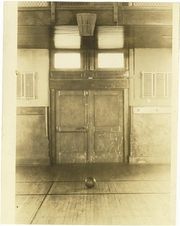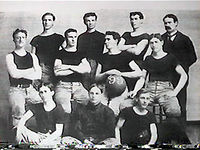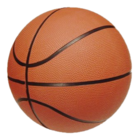James Naismith
| James Naismith | |
|---|---|
 |
|
| A statue of James Naismith | |
| Sport(s) | College basketball |
| Current position | |
| Title | Head coach; Athletic Director |
| Team | University of Kansas |
| Biographical details | |
| Born | November 6, 1861 |
| Place of birth | Almonte, Ontario |
| Died | November 28, 1939 (aged 78) |
| Place of death | Lawrence, Kansas |
| Coaching career (HC unless noted) | |
| 1898–1907 | University of Kansas |
| Head coaching record | |
| Overall | 55 – 60 |
| Accomplishments and honors | |
| Awards | |
| Naismith Memorial Basketball Hall of Fame FIBA Hall of Fame Canadian Basketball Hall of Fame Canadian Olympic Hall of Fame Canadian Sports Hall of Fame Ontario Sports Legends Hall of Fame Ottawa Sports Hall of Fame McGill University Sports Hall of Fame Kansas State Sports Hall of Fame Inventor of basketball |
|
James Naismith[1] (November 6, 1861 – November 28, 1939) was a Canadian and naturalized American sports coach, innovator, college administrator, and college teacher. Dr. Naismith invented the sport of basketball in 1891, and he is often credited with introducing the first football helmet. Dr. Naismith wrote the original basketball rulebook, founded the University of Kansas basketball program, and lived to see basketball adopted as an Olympic demonstration sport in 1904 and as an official event at the 1936 Summer Olympics in Berlin.
Following a number of years as a faculty member and part-time basketball coach—during the sport's fledgling years (1898–1907)—at the University of Kansas, Naismith moved on to further academic obligations at that university, where he also served as the Athletic Director for the Kansas Jayhawks.
Naismith's contributions to basketball have earned him several posthumous honors, such as in the Canadian Basketball Hall of Fame, the Canadian Olympic Hall of Fame, the Canadian Sports Hall of Fame, the Ontario Sports Legends Hall of Fame, the Ottawa Sports Hall of Fame, the McGill University Sports Hall of Fame, the Kansas State Sports Hall of Fame and the FIBA Hall of Fame. The Naismith Memorial Basketball Hall of Fame was named in honor of Dr. Naismith.
Contents |
Biography
Early years
Naismith was born in 1861 in Ramsay Township (now Almonte, Ontario.[2] Struggling in school but gifted in farm labour, Naismith spent his days outside playing catch, hide-and-seek, or duck on a rock, a medieval game in which a person guards a large drake stone from opposing players, who try to knock it down by throwing smaller stones at it. To play duck on a rock most effectively, Naismith soon found out that a soft lobbing shot was far more effective than a straight hard throw, a thought which later proved essential for the invention of basketball.[3] Orphaned early in his life, Naismith lived with his aunt and uncle for many years and attended grade school at Bennies Corners near Almonte. Then he enrolled in Almonte High School, from which he graduated in 1883.[3]
McGill University
In the same year, Naismith entered McGill University in Montreal. Although described as a slight figure, standing 5 foot 10 ½ and listed at 168 pounds,[4] he was a talented and versatile athlete, representing McGill in Canadian football, soccer and gymnastics. He played center on the football team, introduced the first football helmet into regular play[3] and won multiple Wicksteed medals for outstanding gymnastics performances.[5] Naismith earned a BA in Physical Education (1888) and a Diploma at the Presbyterian College in Montreal (1890).[3] From 1891 on, Naismith taught physical education and became the first McGill director of athletics, but then left Montreal to become a physical education teacher at the YMCA International Training School in Springfield, Massachusetts.[5] Naismith is also a member of the Sigma Phi Epsilon Fraternity.
Springfield College: Invention of "Basket Ball"
At Springfield YMCA, Naismith struggled with a rowdy class which was confined to indoor games throughout the harsh New England winter and thus was perpetually short-tempered. Under orders from Dr. Luther Gulick, head of Springfield YMCA Physical Education, Naismith was given 14 days to create an indoor game that would provide an "athletic distraction": Gulick demanded that it would not take up much room, could help its track athletes to keep in shape[5] and explicitly emphasized to "make it fair for all players and not too rough."[4]
In his attempt to think up a new game, Naismith was guided by three main thoughts.[3] Firstly, he analyzed the most popular games of those times (rugby, lacrosse, soccer, football, hockey and baseball); Naismith noticed the hazards of a small fast ball and concluded that the big soft soccer ball was safest. Secondly, he saw that most physical contact occurred while running with the ball, dribbling or hitting it, so he decided that passing was the only legal option. Finally, Naismith further reduced body contact by making the goal unguardable, namely placing it high above the player's heads. To score goals, he forced the players to throw a soft lobbing shot that had proven effective in his old favorite game duck on a rock. Naismith christened this new game "Basket Ball"[3] and put his thoughts together in 13 basic rules.[6]

Picture of the original 1891 "Basket Ball" court in Springfield College. Note the peach basket attached to the wall.

The 1899 University of Kansas basketball team, with Dr. James Naismith at the back, right.

Basketball games at Allen Fieldhouse take place on the James Naismith Court.
|
The first game of "Basket Ball" was played in December 1891. In a handwritten report, Naismith described the circumstances of the inaugural match; in contrast to modern basketball, the players played nine versus nine, handled a soccer ball, not a basketball, and instead of shooting at two hoops, the goals were a pair of peach baskets: "When Mr. Stubbins brot [sic] up the peach baskets to the gym I secured them on the inside of the railing of the gallery. This was about 10 feet from the floor, one at each end of the gymnasium. I then put the 13 rules on the bulletin board just behind the instructor's platform, secured a soccer ball and awaited the arrival of the class... The class did not show much enthusiasm but followed my lead... I then explained what they had to do to make goals, tossed the ball up between the two center men & tried to keep them somewhat near the rules. Most of the fouls were called for running with the ball, though tackling the man with the ball was not uncommon."[7] In contrast to modern basketball, the original rules did not include what is known today as the dribble. Since the ball could only be moved up the court via a pass early players tossed the ball over their heads as they ran up court. Also, following each "goal" a jump ball was taken in the middle of the court. Both practices are obsolete in the rules of modern basketball.[8]
By 1892, basketball had grown so popular on campus that Dennis Horkenbach (editor-in-chief of "The Triangle", the Springfield college newspaper), featured it in an article called "A New Game",[2] and there were calls to call this new game "Naismith Ball", but Naismith refused.[3] By 1893, basketball was introduced internationally by the YMCA movement.[2] From Springfield, Naismith went to Denver where he acquired a medical degree and in 1898 he joined the University of Kansas faculty at Lawrence, Kansas.[4]
University of Kansas
The University of Kansas men's basketball program officially began in 1898, following Naismith's arrival, just six years after Naismith penned the sport's first official rules. Naismith was not initially hired to coach basketball, but rather as a chapel director and physical education instructor.[9] In these early days, the majority of the basketball games were played against nearby YMCA teams, with YMCA's across the nation having played an integral part in the birth of basketball. Other common opponents were Haskell Indian Nations University and William Jewell College. Under Naismith, the team played only three current Big 12 schools: Nebraska (six times), Missouri (twice), and Kansas State (once). Naismith was, ironically, the only coach in the program's history to have a losing record (55–60).[10] However, Naismith coached Forrest "Phog" Allen, his eventual successor at Kansas,[11] who went on to join his mentor in the Basketball Hall of Fame.[12] When Allen became a coach himself and told him that he was going to coach basketball at Baker University in 1904, Naismith discouraged him: "You can't coach basketball; you just play it."[5] Instead, Allen embarked on a coaching career that would lead him to be known as "the Father of Basketball Coaching." During his time at Kansas, Allen coached Dean Smith (1952 National Championship team) and Adolph Rupp (1922 Helms Foundation National Championship team). When Dean Smith retired as head Basketball coach at North Carolina he was the winningest coach in college basketball history, #2 was Adolph Rupp (Kentucky) and #3 was Allen. The three coaches have joined Naismith as members of the Basketball Hall of Fame.
By the turn of the century, there were enough college teams in the East of the U.S. that the first intercollegiate competitions could be played out.[11] Although his sport continuously grew, Naismith long regarded his game as a curiosity and preferred gymnastics and wrestling as better forms of physical education.[11] However, basketball became a demonstration sport at the 1904 Games in St. Louis, USA. As the Basketball Hall of Fame reports, Naismith was also neither interested in self-promotion nor in the glory of competitive sports.[13] Instead, he was more interested in his physical education career, receiving an honorary PE Masters degree in 1910,[3] patrolled the Mexican border for four months in 1916 during World War I, travelled to France, published two books ("A Modern College" in 1911 and "Essence of a Healthy Life" in 1918) and took on American citizenship in 1925.[3]
In 1935, the National Association of Basketball Coaches (created by Naismith's pupil Phog Allen) collected money so that the 74-year old Naismith could witness the introduction of basketball into the official Olympic sports program of the 1936 Summer Olympic Games.[13] There, Naismith handed out the medals to three North American teams; United States, for the Gold Medal, Canada, for the Silver Medal, and Mexico, for their Bronze medal win.[14] During the Olympics, he was named the Honorary President of the International Basketball Federation.[3] When Naismith returned he commented that seeing the game played by many nations was the greatest compensation he could have received for his invention.[11] In 1937, Naismith played a role in the formation of the National Association of Intercollegiate Basketball, which later became the National Association of Intercollegiate Athletics (NAIA).[15]
In his last years, Naismith became Professor Emeritus in Kansas and retired in 1937 at the age of 76. Including his years as coach, Naismith served as athletic director and faculty at the school for a total of almost 40 years. Naismith died in 1939 after he suffered a fatal brain hemorrhage and was buried in Lawrence, KS. Posthumously, his masterwork "Basketball — its Origins and Development" was published in 1941.[3] In Lawrence, Kansas, James Naismith has a road named in his honor, Naismith Drive, which runs in front of Allen Fieldhouse (the official address of Allen Fieldhouse is 1700 Naismith Drive), the university's basketball facility. It is a separated, four-lane road that runs north and south from University Drive south to its end at 24th street, just south of the KU campus.[16] The university also named the court in Allen Fieldhouse, James Naismith Court in his honor. Naismith Hall, a college residential dormitory, is located on the northeastern edge of 19th Street and Naismith Drive.[16]
Coaching record
In 1898, Naismith became the first college basketball coach of the University of Kansas basketball team. He compiled a record of 55–60, and ironically became the only Kansas coach to have a losing record.[10] Nevertheless, Naismith has one of the greatest coaching legacies in basketball history, as he coached Basketball Hall of Fame coach Phog Allen, who himself coached Hall of Fame coaches Dean Smith, Adolph Rupp, and Ralph Miller at the University of Kansas.[11]
| Season | Team | Wins | Losses | Win percentage |
|---|---|---|---|---|
| 1898–99 | Kansas | 7 | 4 | .636 |
| 1899–1900 | Kansas | 3 | 4 | .429 |
| 1900–01 | Kansas | 4 | 8 | .333 |
| 1901–02 | Kansas | 5 | 7 | .417 |
| 1902–03 | Kansas | 7 | 8 | .467 |
| 1903–04 | Kansas | 5 | 8 | .385 |
| 1904–05 | Kansas | 5 | 6 | .455 |
| 1905–06 | Kansas | 12 | 7 | .632 |
| 1906–07 | Kansas | 7 | 8 | .467 |
| Total | Kansas | 55 | 60 | .478 |
Legacy
Naismith is the inventor of basketball and has written the original 13 rules of this sport.[13] The Naismith Memorial Hall of Fame in Springfield, Massachusetts, is named in his honor, and he was an inaugural induction in 1959.[13] The National Collegiate Athletic Association rewards its best players and coaches annually with the Naismith Awards, among them the Naismith College Player of the Year, the Naismith College Coach of the Year and the Naismith Prep Player of the Year. After the Olympic introduction to male athletes in 1936, women's basketball became an Olympic event in Montreal during the 1976 Summer Olympics.[17] Naismith was also inducted into the Canadian Basketball Hall of Fame, the Canadian Olympic Hall of Fame, the Canadian Sports Hall of Fame, the Ontario Sports Legends Hall of Fame, the Ottawa Sports Hall of Fame, the McGill University Sports Hall of Fame, the Kansas State Sports Hall of Fame and the FIBA Hall of Fame.[3]
Basketball is today played by more than 300 million people worldwide, making it one of the most popular team sports.[5] In North America, basketball has produced some of the most-admired athletes of the 20th century. Polls conducted by ESPN and the Associated Press named basketball player Michael Jordan respectively first and second greatest North American athlete of the 20th century, and both polls featured fellow basketballers Wilt Chamberlain (of KU, like Naismith) and Bill Russell in the Top 20.[18][19]
Personal life
Naismith was the eldest child of Margaret and John Naismith, two Scottish immigrants. His mother, Margaret Young, was born in 1833 and immigrated as the fourth of 11 children to Lanark County, Canada in 1852.[3] His father, John Naismith, was born in 1836, left Europe when he was 18 and also settled down in Lanark County.[3] After marrying, John Naismith worked as a saw hand, but unfortunately, the couple soon contracted typhoid fever and died when Naismith was just 9 years old.[1] He was then raised by a strict, religious grandmother and his uncle Peter.[1]
On June 20, 1894, Naismith married Maude E. Sherman from Springfield. The couple had five children: Margaret Mason (1895), Helen Carolyn (1897), John Edwin (1900), Maude Ann (1904) and James Sherman (1913).[4] He was a member of the Pi Gamma Mu and Sigma Phi Epsilon fraternities,[4] and regarding his spiritual beliefs, Naismith is remembered as a Freemason.[20] Maude Naismith died in 1937, and on June 11, 1939, he married his second wife Florence Kincaid. Naismith suffered a major brain hemorrhage on November 19 the same year and died nine days later in his home located in Lawrence, Kansas.[21] Naismith was 78 years old.[1] Naismith is buried in Memorial Park Cemetery in Lawrence, KS.[22]
During his lifetime, Naismith's education and academic positions held were as follows:[4]
| Location | Position | Period | Remarks |
|---|---|---|---|
| Bennie's Corner Grade School (Ontario) | Primary school | 1867–1875 | |
| Almonte High School | Secondary school | 1875–1877, 1881–83 | Dropped out and reentered |
| McGill University | University student | 1883–87 | |
| McGill University | Instructor in Physical Education | 1887–1890 | Gold Wickstead Medal (1887), Best All-Around Athlete; Silver Cup (1886), first prize for one-mile walk; Silver Wickstead Medal (1885), Best All-Around Athlete; Awarded one of McGill's first varsity letters |
| McGill: Thool Seminary | Education in Theology | 1887–1890 | Silver medal (1890), second highest award for regular and special honor work in Theology |
| Springfield College | Instructor in Physical Education | 1890–1895 | Invented "Basket Ball" in December 1891 |
| YMCA of Denver | Instructor in Physical Education | 1895–1898 | |
| University of Kansas | Instructor in Physical Education and Chapel Director | 1898–1909 | |
| University of Kansas | Basketball Coach | 1898–1907 | First-ever campus basketball coach |
| University of Kansas | Professor and University Physician | 1909–1917 | Hiatus from 1914 on due to World War I |
| First Kansas Infantry | Chaplain/Captain | 1914–1917 | Military service due to World War I |
| First Kansas Infantry (Mexican Border) | Chaplain | 1916 | |
| Military & YMCA secretary in France | Lecturer of Moral Conditions and Sex Education | 1917–1919 | |
| University of Kansas | Athletic Director | 1919–1937 | Emeritus in 1937 |
Notes
- ↑ 1.0 1.1 1.2 1.3 "James Naismith Biography". bookrags.com. http://www.bookrags.com/biography/james-naismith/. Retrieved 2008-09-30.
- ↑ 2.0 2.1 2.2 Laughead, George. "Dr. James Naismith, Inventor of Basketball". Kansas Heritage Group. http://www.kansasheritage.org/people/naismith.html. Retrieved 2008-09-30.
- ↑ 3.00 3.01 3.02 3.03 3.04 3.05 3.06 3.07 3.08 3.09 3.10 3.11 3.12 3.13 "Dr. James Naismith". Naismith Museum And Hall of Fame. http://www.naismithmuseum.com/naismith_drjamesnaismith/main_drjamesnaismith.htm. Retrieved 2008-09-30.
- ↑ 4.0 4.1 4.2 4.3 4.4 4.5 Dodd, Hellen Naismith (January 6, 1959). "James Naismith's Resume". Naismith Memorial Basketball Hall of Fame. http://hoophall.com/history/naismith-resume.html. Retrieved 2008-09-30.
- ↑ 5.0 5.1 5.2 5.3 5.4 Zukerman, Earl (December 17, 2003). "McGill grad James Naismith, inventor of basketball". Varsity Sports News. McGill Athletics. http://athletics.mcgill.ca/varsity_sports_article.ch2?article_id=110. Retrieved 2008-09-30.
- ↑ Naismith, James. "Dr. James Naismith's 13 Original Rules of Basketball". National Collegiate Athletic Association. http://www.ncaa.org/champadmin/basketball/original_rules.html. Retrieved 2008-09-30.
- ↑ Naismith, James. "James Naismith Handwritten Manuscript Detailing First Basketball Game". Heritage Auction Galleries. http://sports.ha.com/common/view_item.php?Sale_No=706&Lot_No=19007&type=prte-pr11136b&ic=. Retrieved 2008-09-30.
- ↑ "Official basketball rules". International Basketball Federation. http://www.fiba.com/pages/eng/fc/FIBA/ruleRegu/p/openNodeIDs/897/selNodeID/897/baskOffiRule.html. Retrieved 2008-09-30.
- ↑ Chimelis, Ron. "Naismith Untold". Naismith Memorial Basketball Hall of Fame. http://www.hoophall.com/history/naismith-untold-story.html. Retrieved 2008-09-30.
- ↑ 10.0 10.1 "Naismith's Record". kusports.com. http://www.kusports.com/basketball/history/naismith/naismith_record.html. Retrieved 2008-09-30.
- ↑ 11.0 11.1 11.2 11.3 11.4 "James Naismith, A Kansas Portrait". Kansas Historical Society. http://www.kshs.org/portraits/naismith_james.htm. Retrieved 2008-09-30.
- ↑ "Forrest C. "Phog" Allen". Naismith Museum And Hall of Fame. http://hoophall.com/halloffamers/bhof-phog-allen.html. Retrieved 2008-09-30.
- ↑ 13.0 13.1 13.2 13.3 "Hall of Fame Feature: James Naismith". Naismith Memorial Basketball Hall of Fame. http://hoophall.com/halloffamers/bhof-james-naismith.html. Retrieved 2008-09-30.
- ↑ "James Naismith, the inventor of basketball". collegesportsscholarships.com. http://www.collegesportsscholarships.com/basketball-inventor-james-naismith.htm. Retrieved 2008-09-30.
- ↑ Kerkhoff, Blair. "The NAIA basketball tournament? Throw 32 teams in the same building and see which is the last one standing at the end of a weeklong frenzy". http://findarticles.com/p/articles/mi_m1208/is_10_230/ai_n26787758m. Retrieved 2008-09-30.
- ↑ 16.0 16.1 "Google Maps Route". Google Maps. http://maps.google.com/maps?f=d&saddr=Naismith+Drive+and+24th+St,+Lawrence,+Kansas&daddr=Naismith+Drive+and+W+University+Drive&hl=en&geocode=&mra=ls&sll=38.95045,-95.25601&sspn=0.027701,0.052013&ie=UTF8&ll=38.950799,-95.251207&spn=0.027701,0.052013&t=h&z=14. Retrieved 2008-09-30.
- ↑ Jenkins, Sally. History of women's basketball "History of women's basketball". WNBA.com. Women's National Basketball Association. http://www.wnba.com/about_us/jenkins_feature.html History of women's basketball. Retrieved 2008-09-30.
- ↑ "Top N. American athletes of the century". ESPN.com. http://espn.go.com/sportscentury/athletes.html. Retrieved 2008-09-30.
- ↑ Associated Press (1999-12-21). "Top 100 athletes of the 20th century". USA Today. http://www.usatoday.com/sports/ssat2.htm. Retrieved 2008-09-30.
- ↑ "James Naismith". Grand Lodge of British Columbia and Yukon. http://freemasonry.bcy.ca/biography/naismith_j/naismith_j.html. Retrieved 2008-09-30.
- ↑ "Naismith Museum & Hall of Fame: Biography of James Naismith". http://www.naismithmuseum.com/naismith_drjamesnaismith/main_drjamesnaismith.htm. Retrieved 2008-12-12.
- ↑ "James Naismith". http://www.findagrave.com/cgi-bin/fg.cgi?page=gr&GRid=753. Retrieved 2009-08-30.
External links and references
- Basketball Hall of Fame profile
- Naismith Foundation
- Original 13 basketball rules by Dr. James Naismith
- FIBA Hall of Fame profile
- James Naismith at Find a Grave
- Works by or about James Naismith in libraries (WorldCat catalog)
|
|||||||||||||||||||
|
|||||
|
|||||||||||||||||
|
|||||||||||||||||||||||||||||||||||||||||||||||||||||||||||||||||||||
